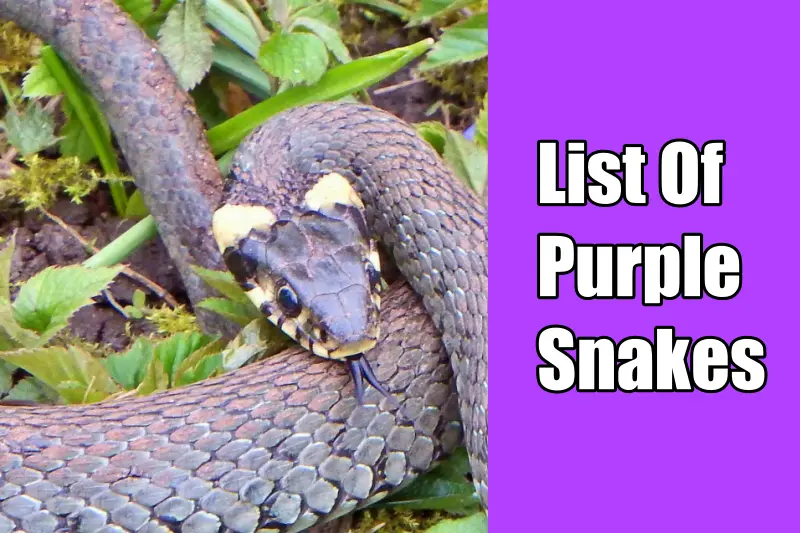Snakes are the most common reptiles found all across the world. Most of the snakes are black, brown, or green, but a few species of snakes can be purple. These purple snakes are such an uncommon and rare sight to see.
They are popular among snake lovers due to their unique coloration. This purple coloration adds to the aesthetic value and is also used with camouflage. In this article, we will cover 22 purple snakes found in nature and their characteristics.
22 Real Purple Snakes
1. Common Purple Glossed Snake
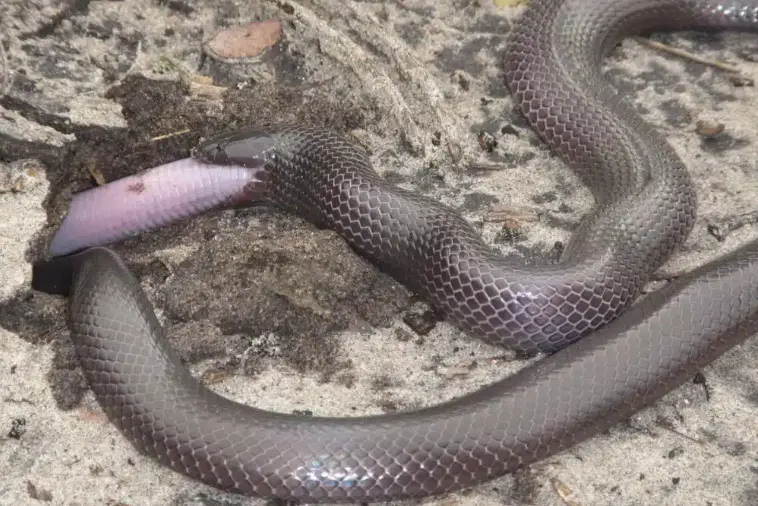
| Scientific name | Amblyodipsas polylepis |
| Size | 75 to 110 cm |
| Diet | Skinks, Blind snakes, and worm snakes |
| Geographical location | KwaZulu-Natal, Limpopo, Swaziland, southern and central Mozambique, Zimbabwe, and northern Botswana |
A common purple-glossed snake is known for its blunt head and purple-glossy appearance. These mildly venomous snakes are native to Africa, from Limpopo to Botswana.
These oviparous species mostly prefer other reptiles, like blind snakes, skinks, etc. as their food.
They are large, with an average size of 75 to 110 cm. They are often mistaken for other snakes with glossy skins. Their venom is not considered dangerous to humans.
2. Madurai shield tail
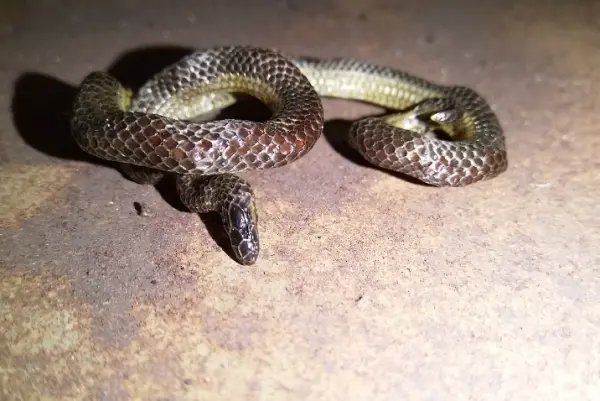
| Scientific name | Platyplectrurus madurensis |
| Size | 35 cm |
| Diet | invertebrates especially earthworms |
| Geographical location | Western Ghats of India and Sri Lanka |
Travancore Hills thorn tail snake, Palni purple-brown worm thorn tail snake, or Madurai shield tail are some of the common names of Platyplectrurus madurensis. These snakes have purplish brown and white scales with purple-brown borders.
These Madurai shield tails mainly feed on earthworms and other small invertebrates. They can attain a length of up to 35 cm. It is a burrowing snake, rarely seen on the grounds, and mostly prefers moist environments to stay.
The Madurai Shield tail, primarily displaying a deep purple hue, earns its name from the vibrant yellow accents adorning its tail tips.
This snake boasts a distinctive dark purple coloration, ranging from near-black shades to rich and deep purples. This gradation commences at the head and reaches its zenith in brightness at the tail’s extremity.
Additionally, the Madurai Shield tails exhibit flashes of yellow amidst the purplish dorsal markings.
3. Western blind tail
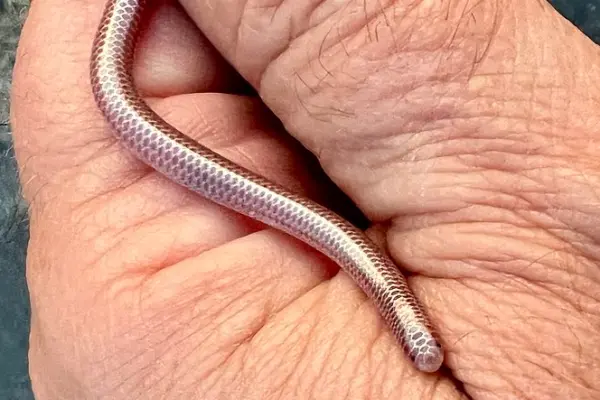
| Scientific name | Rena humilis |
| Size | less than 30 cm |
| Diet | eggs and larvae of termites and ants |
| Geographical location | Southwestern United States and Mexico |
The other snake on our list is the Western blind snake. As their snake indicates, their eyes are vestigial as they live in burrows. These Western blind snakes are pink, purple, or silvery brown with two black eyespots for light detection.
They usually feed on insects and their larvae and are known to invade ant and termite colonies. They are small, with an average size of 30 cm. One can easily find these snakes in the southwestern United States and Mexico.
4. Cape file snake

| Scientific name | Limaformosa capensis |
| Size | 120 to 165 cm |
| Diet | Ophiophagous |
| Geographical location | Africa |
Cape file snakes, or Limaformosa capensis, are commonly found in Africa. They are usually black to brown but exist in olive or purple morph form as well.
These snakes have a variety of habitats, including shrubland, savanna, and forests, where they can live peacefully.
These nonvenomous snakes primarily feed on other snakes. They are immune to all other snakes’ venoms and are considered their biggest predators. They are not aggressive and only bite when they feel threatened.
5. Mangrove pit viper
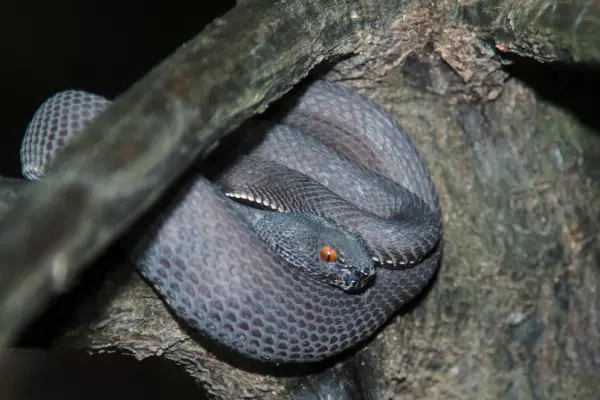
| Scientific name | Trimeresurus purpureomaculatus |
| Size | 66 to 90 cm |
| Diet | lizards, frogs, and small animals |
| Geographical location | Bangladesh, India, Thailand, Malaysia, Burma, Singapore, Indonesia |
These venomous snakes are endemic to South and Southeast Asia, including Bangladesh, India, Thailand, Malaysia, Burma, Singapore, and Indonesia. These pit vipers vary in colors, like olive, brown, and purple.
These snakes have sexual dimorphism, where females are larger than males, and their size ranges from 66 to 90 cm.
Mangrove pit viper, mangrove viper, shore pit viper, purple-spotted pit viper, and shore pit viper are common names of Trimeresurus purpureomaculatus. These highly venomous snakes are very aggressive and strike very fast.
6. Eastern purple glossed snake
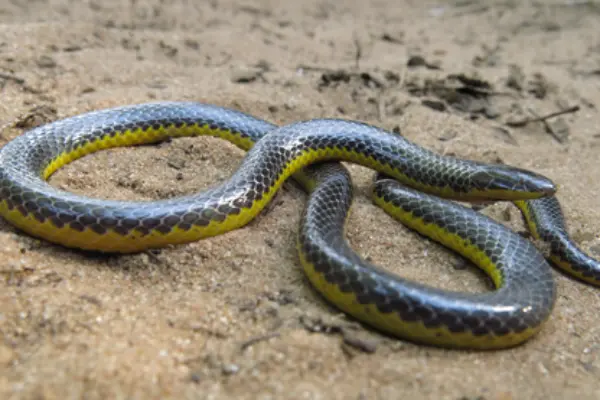
| Scientific name | Amblyodipsas microphthalmia |
| Size | 12 inches |
| Diet | Skinks, Other small snakes |
| Geographical location | South Africa |
Another snake species from the purple-glossed snake genus Like common purple-glossed snakes, they are also mildly venomous snakes. As the name indicates, they are dark brown with a purple gloss.
These eastern purple-gloss snakes can attain a size of up to 12 inches. One can find this species in South Africa. These snakes are nocturnal and hunt down mammals and birds like others in their genus.
The white-lipped snake is also a common name for this snake due to the whiteness of its ventral edges that resemble the lips.
7. Olive Sea Snake
| Scientific name | Aipysurus laevis |
| Size | 3-6 feet |
| Diet | small fishes, invertebrates, prawn,s and crabs |
| Geographical location | Southwestern pacific ocean |
Golden sea snake, olive sea snake, and olive-brown sea snake are the common names for Aipysurus laevis. According to research, they are considered the most venomous sea snakes.
One of the most interesting facts about these snakes is that they can stay in water for two straight hours without taking a breath. These snakes are commonly found in coral reefs in the Southwestern Pacific Ocean.
They are not aggressive but bite when they feel threatened, and their venom even leads to death. Their bodies have a purplish blue shade with a brown head.
The Olive Sea Snake distinguishes itself through a unique brown-purple coloration that blankets its entire body, a rarity in the snake world. Certain variations even feature a distinct brown hue on their heads.
What sets this species apart is the presence of a vivid purple shading that overlays a base of brown undertones, all beneath the protection of notably large scales.
8. Purple Ball python
| Scientific name | Python regius |
| Size | 182 cm |
| Diet | Small animals and birds |
| Geographical location | West sub-Saharan Africa |
Ball pythons, or Phyton regius, are very popular among snake lovers because of their unique and beautiful colored morphs. Their purple morphs are purple with white strips and black-brown eyes.
These non-venomous snake species are commonly found in West Sub-Saharan Africa, inhabiting grasslands, shrublands, and open forests. They are quite large, with a size of 182 cm.
These nocturnal snakes can curl into balls when they are frightened. Like other pythons, they also prefer small mammals and birds to feed on.
9. Sharp-tailed snake
| Scientific name | Contia tenuis |
| Size | 30 to 46 cm |
| Diet | Slugs and their eggs and earthworms |
| Geographical location | North America |
These snake species are endemic to North America, including the western United States and British Columbia. As their name indicates, they have sharp spine tails, although this spine is not dangerous.
It is medium-sized, with an average body length of 30 to 46 cm. They are quite shy and secretive, and they are rarely found in public. It mostly prefers slugs and their eggs, and sometimes also eats earthworms.
They are oviparous and lay up to 4 to 16 eggs in the clutch. It is commonly mistaken for earthworms due to its similar appearance to normal people. They are shy and coiled themselves when encountered by someone.
10. Western Glossy Snake
| Scientific name | Amblyodipsas unicolor |
| Size | 15 inches |
| Diet | mice and small rodents |
| Geographical location | Africa |
Another member of the purple-glossed snake family is the Western glossy snake. These venomous snake species are commonly found in all parts of Africa. They are not considered dangerous to humans, as their venom is only toxic to small animals.
Talking about their appearance, they are blackish brown with a purple gloss, which is characteristic of the Amblyodipsas genus. They are large, with a size of 15 inches.
They are famous among snake lovers and breeders due to their glossy purple appearance and non-aggressive nature. These nocturnal snakes mostly feed on mice and other small rodents. They are known for their unique tricks to tackle threats.
11. Bamboo Snake
| Scientific name | Pseudoxenodon bambusicola |
| Size | 1 m |
| Diet | small frogs, lizards |
| Geographical location | China, Vietnam, and Thailand |
Bamboo snake or bamboo false cobra are some of the common names of Pseudoxenodon bambusicola. They are gray and brown with a purple hue.
They are medium-sized and can attain up to a size of 1 m. One can find these snakes in China, Vietnam, and Thailand. As their name suggests, they live in bamboo grooves.
They vary in color from brown to purple with red and black markings. They are known as a false cobra as they raise their head and resembles the hood of cobras.
12. California king snake
| Scientific name | Lampropeltis californiae |
| Size | 76 to 107 cm |
| Diet | Ophiophagous |
| Geographical location | Western United States and Northern Mexico |
The California king snake is commonly found in the Western United States and Northern Mexico. They are referred to as king snakes because of their ability to eat other snakes. It exists in many morph forms with a purple base and white markings.
They live in a variety of habitats, including woodland chaparral, grassland, deserts, marshes, river bottoms, and even suburban areas. These diurnal snakes are primarily terrestrial and can climb on short branches.
They are very common as pets and are found all across the world among snake lovers.
13. Banded rock rattlesnake
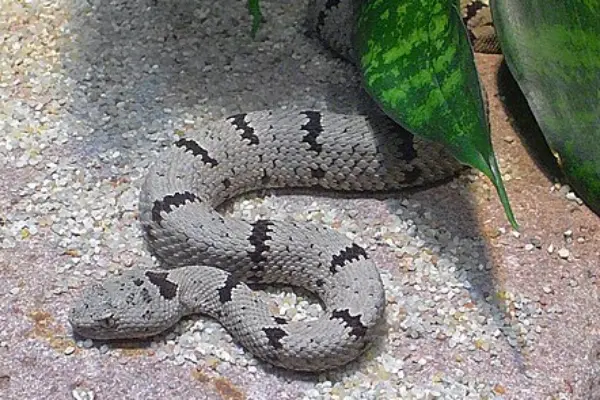
| Scientific name | Crotalus lepidus |
| Size | 24 inches |
| Diet | Lizards, Invertebrates, and small mammals |
| Geographical location | Arizona, New Mexico, and Texas |
Rattlesnakes, apart from their aggressive nature and being known for their unique appearances, are quite venomous, with an average body size of 24 inches. These banded rock rattlesnakes are commonly found in Arizona, Mexico, and Texas.
These nocturnal animals usually camouflage according to their surroundings. They are quite shy, don’t like to travel a lot, and like to live under rocks, even for their entire lives.
14. Brahminy blind snake
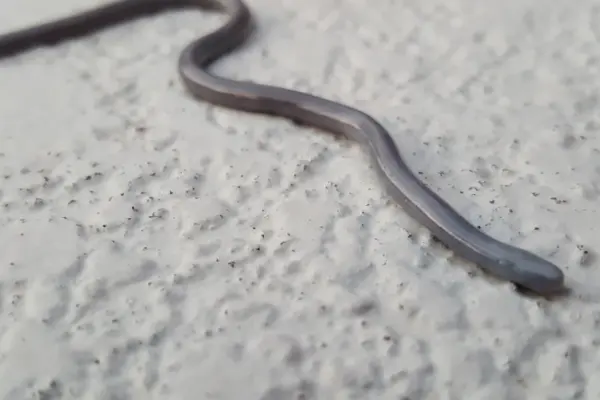
| Scientific name | Indotyphlops braminus |
| Size | 5 to 10 cm |
| Diet | ant and termites eggs and larvae |
| Geographical location | Asia, Africa, America, Australia |
This fossorial snake species is commonly found in Asia, Africa, America, and Australia. They are the smallest snake species, with an average size of 5 to 10 cm. These snake species are parthenogenic, and only females are present in their population.
It occurs in variable colors, from brown to purple. They usually reside in habitats like urban and agricultural areas. They mostly prefer ant and termite eggs and larvae to feed on.
As their name indicates, they are blind, which means their eyes are covered with translucent scales and can only detect light. They highly resemble earthworms in their habitat and appearance.
15. Albino (Purple Phase) Reticulated python
| Scientific name | Malayopython reticulatus |
| Size | 6 to 7m |
| Diet | Birds, fishes, and small primates |
| Geographical location | South and Southeast Asia |
Reticulated pythons are the longest and third-heaviest snakes in the world, ranging from 6 to 7 m in length. Like all phytons, they are also non-venomous and have constricting power. The given picture, it’s showing the purple phase albino reticulated python. This purple morph has an orange body with purple remarkable markings.
It is commonly used for its skin, as pets, and for medicinal purposes. They live in a variety of habitats, including rainforests, woodlands, and grasslands. They are oviparous, with 15 to 80 eggs in every breeding season.
16. Natal Purple-glossed snake
| Scientific name | Amblyodipsas concolor |
| Size | 19 cm |
| Diet | mammals, reptiles ,and birds |
| Geographical location | Southern Africa |
Again, we have a member of the Atractaspididae family, i.e., the purple-gloss snake family. The natal purple-glossed snake, or KwaZulu-Natal purple-glossed snake, is commonly found in southern Africa.
These snakes are venomous and have remarkable dark brown or purple-brown skin with a purplish gloss. These snakes are quite short, with an average size of 19 cm, and the maximum length reported yet is 27.5 cm.
They are docile and rarely attempt to bite. Their venom is not dangerous for humans. Natal purple-gloss snakes are nocturnal and hunt down mammals, reptiles, and birds, like other snakes in their family.
17. Lavender Corn snake ( Mocha morph)
| Scientific name | Pantherophis guttatus |
| Size | 4 to 5 feet |
| Diet | rodents and reptiles |
| Geographical location | United States |
Corn snakes are the most common type of rat snake found in the United States. As their name indicates, these lavender forms are so pretty, with red eyes and purple-white color patterns. These nocturnal snake species are considered very good tree climbers.
These corn snakes are medium-sized, with an average size of 4 to 5 feet. These snakes are carnivorous and mostly prefer rodents, reptiles, or amphibians to feed on.
18. Purple glossy snake
| Scientific name | Arizona elegans |
| Size | 75 to 110 cm |
| Diet | small lizards |
| Geographical location | Southwestern United States and Mexico |
Another unique purple snake on our list is a purple glossy snake, i.e., Arizona elegans. They are medium-sized, with a 75- to 110-cm body length. These glossy snakes are endemic to the southwestern United States and Mexico.
It lives in a variety of habitats, including semi-arid grasslands. These nonvenomous snakes are oviparous. As their name indicates, they are purple and glossy in color with flashy bodies. These nocturnal animals mostly prefer small lizards to feed on.
19. California Red-sided Garter snake
| Scientific name | Thamnophis sirtalis infernalis |
| Size | 1.2 m |
| Diet | amphibians and small mammals |
| Geographical location | North America |
The Thamnophis sirtalis infernalis, or purple garter snake, is the most common purple snake found in North America. They are medium-sized with a 1.2-meter body length.
As their name indicates, they are purple or blue with many longitudinal stripes. They are venomous, and their venom is not dangerous for humans and can only kill amphibians and small animals.
They have amazing and unique characteristics, and one of them is that they make mating balls during the breeding season, which include one or two females encircled by many males. These ovoviviparous snakes are considered endangered in many parts.
20. Purple Line Snow Western Hognose
| Scientific name | Heterodon nasicus |
| Size | 40 to 50 cm |
| Diet | toads, frogs, lizards and birds |
| Geographical location | North America |
They are known as hognose snakes due to their upturned noses. The western hognose snake is commonly found in North America. They exist in almost 60 distinct morphs.
But their Levander morphs are the most beautiful ones, which have a Levander base and dark purple blotches all over the body. They often act as cobras when they feel frightened.
They are often taken as pets due to their mildly aggressive nature and adorable upturned nose. It is small, with a body size of 40 to 50 cm, where females are comparatively larger than males.
21. Snow Glow Jungle Boa Constrictor
| Scientific name | Boa constrictor |
| Size | 3 to 13 ft. |
| Diet | Small mammals and birds |
| Geographical location | South America |
These South American natives are very popular in the pet trade due to their unique morph forms. They are quite large and can grow up to 3 to 13 feet. Among all snake pets, large ones are not preferred if you are a beginner.
They vary in color a lot, from brown to gray. Their snow glow morph is pretty, with a white background and purple patches all over the body. They live in a wide variety of habitats, from deserts to rainforests.
They are solitary and only interact with other snakes during breeding. These nocturnal species are carnivorous and mainly prefer small mammals and birds to feed on. Boa constrictors are viviparous, which means they give birth to young ones.
22. Big-headed snail-eating snake
| Scientific name | Dipsas indica |
| Size | 106 to 116 cm |
| Diet | Snails and slugs |
| Geographical location | Amazon Basin. |
Neotropical Snail-Eater, Amazonian Snail-Eater, and Big-headed Snail-Eating Snakes are some of the common names of Dipsas indica. They usually have grayish bodies with blackish-yellow blotches.
But its purple morph is unique and rare and has a purple body with dark purple blotches. These snakes mainly inhabit evergreen forests, forest edges, plantations, and banana groves. These nocturnal snakes are not aggressive and are harmless to humans.
They have the unique feature of flattening their bodies and producing foul odors when threatened. One can find these beautiful snakes throughout the Amazon basin.
Conclusion
In conclusion, purple snakes are beautiful yet dangerous creatures. Not all of them are venomous. These snakes are very common and popular among snake lovers and breeders because of their unique colors and patterns, which make them unique and sight-worthy.
But the question arises: why are they purple? They possess this unique purple coloration due to chromatophore skin cells. So if you ever encounter this group of snakes, first identify them and then approach them, as they can be dangerous as well. We hope you like this article. We will be back with another article soon.
Frequently asked questions:
Q1) Are there any real purple snakes?
As you can see in the article above, there are a lot of purple snakes that exist in nature, like the Cape File snake, Western glossy snake, Olive Sea snake, etc., and there is a lot to discover.
Q2) Are purple snakes venomous?
Not all purple snakes are venomous, but some are, like the mangrove pit viper, the olive sea snake, the banded rock rattlesnake, etc.
Q3) What do purple snakes eat?
Like any other snake, purple snakes feed on varieties of animals like lizards, birds, worms, insects, small fish, other small mammals and some time on other snakes (as the common purple-glossed snake feeds on blind snakes, etc.).
Q4) Can purple snakes make good pets?
Purple snakes are very famous among snake lovers due to their unique purple coloration and rarity.
Depending on species, some are considered very good pets, like the snow-glow jungle boa constrictor, the purple ball python, etc., due to their shy and docile temperament and non-venomous nature.
But before purchasing one, one should do some study on them.
Q5) How rare are purple snakes?
Compared to other snake species, purple snakes are considerably rarer and less common in the wild.
However, in response to the rising demand, breeders are now working to produce snakes with unusual colors for enthusiasts of snakes; one such creation is the purple passion ball python, which was just produced.
Because they are uncommon and well-liked by snake enthusiasts, their rarity not only makes them admirable but also advantageous to the snake dealers.
Also Read:

Being a zoology student I’m always been fascinated toward animals especially insects. I love to do research and learn about different animals. As a writer I want to share my thoughts about nature through my articles. Apart from this you can find me exploring the new places and voice notes.
